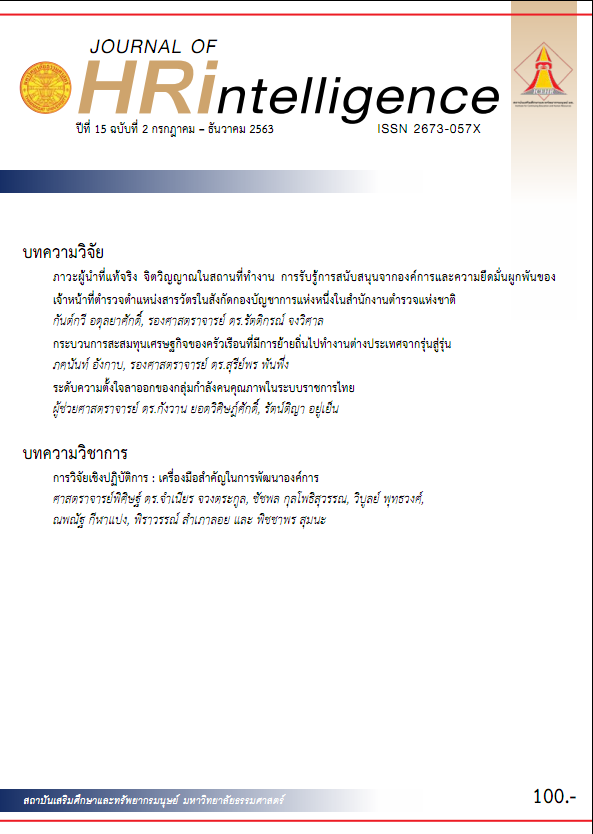Authentic Leadership, Workplace Spirituality, Perceived Organizational Support and Police Inspector Engagement in a Police Bureau in The Royal Thai Police
Main Article Content
Abstract
The objectives of this research were to study 1) the level of authentic leadership, workplace spirituality, perceived organizational support and employee engagement, 2) the relationship between authentic leadership, workplace spirituality, perceived organizational support and employee engagement and 3) to study influence of authentic leadership, workplace spirituality, perceived organizational support on employee engagement. The samples of this research had been taken from 207 police inspectors in a police bureau in The Royal Thai Police. The data was collected through questionnaires. The results showed that 1) The level of authentic leadership and employee engagement were rather high. The level of workplace spirituality and perceived organizational support were medium. 2) Authentic leadership and workplace spirituality had positive relationship with employee engagement at .01 level of significance. Perceived organizational support had positive relationship with employee engagement at .05 level of significance. 3) Authentic leadership and workplace spirituality could predict 15.1% of employee engagement at .001 level of significant.
Article Details
ขอมอบลิขสิทธิ์บทความที่ได้รับการตีพิมพ์ให้แก่สถาบันเสริมศึกษาและทรัพยากรมนุษย์ กรณีมีการฟ้องร้องเรื่องการละเมิดลิขสิทธิ์เกี่ยวกับภาพ กราฟ ข้อความส่วนใดส่วนหนึ่ง และ/หรือข้อคิดเห็นที่ปรากฎในบทความ ให้เป็นความรับผิดชอบของข้าพเจ้าและผู้เขียนร่วมแต่เพียงผู้เดียว
References
Aon Hewitt. (2015). Re: Trends in Global Employee Engagement Making engagement happen. Retrieved on October 12, 2015 from http://www.aon.com/puertorico/attachments/recursos-humanos/Final%20Trends%20in%20Global%20Employee%20Engagement%20Report%202015%20.pdf
Banchong, W., Khruahong, T., Phatthanaviriyapisan, A., & Piman, S. (2015).Significant Factors of Employee Engagement Prediction. The Journal of Faculty of Applied Arts, 8(1), 21-31.
Baumruk, R., Gorman, B., & Gorman, R. E. (2006). Why managers are crucial to increasing engagement. Strategic HR Review, 5(2), 24-27.
Chongvisal, R. (2012a). Factors effecting job satisfaction and employee engagement. Kasetsart Journal Social Sciences, 33(2), 188-202.
Chongvisal, R. (2012b). Leadership, Workplace Spirituality, Job Performance and Good Corporate Governance. NIDA Development Journal, 52(1), 101-129.
Chongvisal, R. (2013). Leadership: Theories, Research, and Approaches to Development. Bangkok: Chulalongkorn University Printing House.
Chongvisal, R. (2018). Organizational Psychology. Bangkok: Chulalongkorn University Printing House.
Eastman, P. (2014). The bottom line of authentic leadership. Leadership Excellence, 31(4), 42.
EconNews. (2015). Re: Economic crime after entering AEC [Online News]. Retrieved from http://www.econnews.co.th/%E0%B8%AD%E0%B8%B2%E0%B8%8A%E0%B8%8D%E0%B8%B2%E0%B8%81%E0%B8%A3%E0%B8%A3%E0%B8%A1%E0%B8%97%E0%B8%B2%E0%B8%87%E0%B9%80%E0%B8%A8%E0%B8%A3%E0%B8%A9%E0%B8%90%E0%B8%81%E0%B8%B4%E0%B8%88-aec/
Eisenberger, R., Huntington, R., Hutchison, S. & Sowa, D. (1986). Perceived organizational support. Journal of Applied Psychology, 71(3), 500-507.
Eisenberger, R., Armeli, S., Rexwinkel, B., Lynch, P. D., & Rhoades, L. (2001). Reciprocation of Perceived Organizational Support. Journal of Applied Psychology, 86(1), 42-51.
Hassan, S., Hassan, M., & Shoaib, M. (2014). Measuring the impact of perceived organization support, psychological empowerment and rewards on employees’ satisfaction: testing the mediating impact of employee engagement. World Applied Sciences Journal, 30(5), 652-660.
Jurkiewicz, C. L., & Giacalone. R. A. (2004). A value framework for measuring the impact of workplace spirituality on organizational performance. Journal of Business Ethic, 49(2), 129-142.
Khuankaew, T. (2011). Relationship between perceived organizational justice, perceived organizational support and organizational citizenship behaviors of operational employees : a case study of an electronic components manufacturer. (Master’s thesis). Thammasat University, Bangkok.
Krejcie, R. V., & Morgan, D. W. (1970). Determining sample size for research activities. Educational and Psychological Measurement, 607-610.
Krishman, J., & Mary, V. S. (2012). Perceived organizational support – an overview on its antecedents and consequences. International Journal of Multidisciplinary Research, 2(4), 1-13.
Men, L.R. (2015). Employee engagement in relation to employee–organization relationships and internal reputation: effects of leadership communication. Public relations Journal, 9(2). Retrieved from http://www.prsa.org/Intelligence/PRJournal/Vol9/No2/
Northhouse, P. G. (2010). Leadership: Theory and practice. (5th ed.). California: SAGE Publications, Inc.
Policemuseum Parutsakawan Palace. (n.d.). Thai police history. Retrieved from https://saranitet.police.go.th/museum/?page_id=337
Ram, P., & Prabhakar, G. V. (2011). The role of employee engagement in work-related outcomes. Interdisciplinary Journal of Research in Business, 1(3), 47-61.
Rassmeethamchote, S. (2013). Employee Engagement in Practice. Bangkok: Eastern Printing Public Co., Ltd.
Rhoades, L., & Eisenberger, R. (2002). Perceived organizational support: A review of the literature. Journal of Applied Psychology, 87(4), 698-714.
Royal Thai Police. (2016). Royal Thai Police action plan B.E. 2559. Retrieved from http://www.strategypolice.com/webdatas/DraftPlan2559.pdf
Royal Thai Police. (2018). Royal Thai Police action plan B.E. 2561. Retrieved from https://www.royalthaipolice.go.th/downloads/plan61.pdf
Royal Thai Police. (n.d.). Vision. Retrieved from http://www.royalthaipolice.go.th/vision.php
Rubel, M. R. B., & Kee, D. M. H. (2013). Perceived support and employee performance: the mediating role of employee engagement. Life Science Journal, 10(4), 2557-2567.
Saengmukda, S., & Sumettikun, P. (2013) The Development of Authentic Leadership Measurement tools for Basic Education Institution Administrators. Journal of Education Studies, 41(3), 83-97.
Saenthong, N. (2005). Modern Human Resources Management in Practice. Bangkok: HR Center Co., Ltd.
Saks, A.M. (2006). Antecedents and consequences of employee engagement. Journal of Managerial Psychology, 21(7): 600-619.
Saks, A.M. (2011). Workplace spirituality and employee engagement. Journal of Management, Spirituality & Religion, 8(4), 317-340.
Suan, C. L., Mat, N., & Kandayah, J. A. (2011). Perceptions of authentic leadership and its impact on employee engagement: a case of Malaysia semiconductor manufacturing firm. Elixir International Journal, 41, 5871-5876.
Subramaniam, M., & Panchanatham, N. (2013). A study of spirituality in a public sector bank in India. International Journal of Advances in Management and Economics, 2(4), 102-113.
Sundaray, B. K. (2011). Employee Engagement: A Driver of Organizational Effectiveness. European Journal of Business and Management, 8(3), 53-59.
Suwanwet, S. (2006). Empolyee Engagement. Retrieved from www.pmat.or.th.
Vinitchainan, J. (2015, February 11). What's kind of effective tools for employee mindset measurement?. Posttoday, pp. B3.
Walumbwa, F. O., Avolio, B. J., Gardner, W. L., Wernsing, T. S., & Peterson, S. J. (2008). Authentic leadership: development and validation of a theory-based measure. Journal of Management, 34(1), 89-126.
Wang, D. S. & Hsieh, C. C. (2013). The effect of authentic leadership on employee trust and employee engagement. Social behavior and personality, 41(4), 613-624.
Wayne, S. J., Shore, L. M. & Liden, R. C. (1997). Perceived organizational support and leader-member exchange: A social exchange perspective. Academy of Management Journal, 40(1), 82-111.


